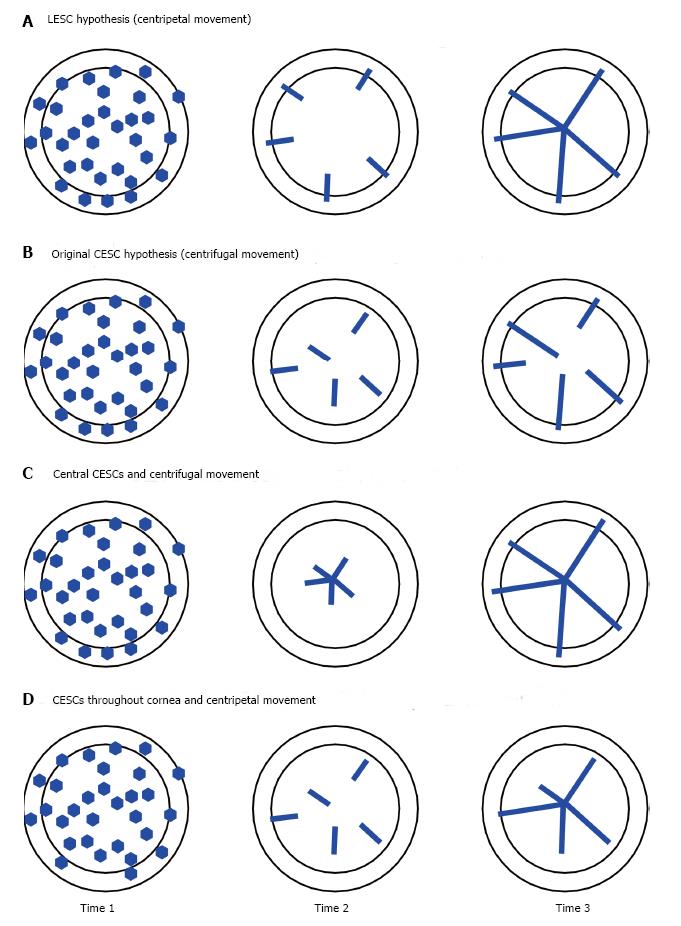Copyright
©The Author(s) 2015.
World J Stem Cells. Mar 26, 2015; 7(2): 281-299
Published online Mar 26, 2015. doi: 10.4252/wjsc.v7.i2.281
Published online Mar 26, 2015. doi: 10.4252/wjsc.v7.i2.281
Figure 5 Hypothetical results from a lineage tracing experiment to distinguish between the limbal epithelial stem cell and corneal epithelial stem cell hypotheses.
In each figure the inner disc represents the corneal epithelium and the outer ring represents the limbal epithelium. If a reporter transgene is driven by a tamoxifen-inducible, ubiquitous promoter, a proportion of all the cell types in the ocular surface (and other tissues) will be labelled shortly after tamoxifen treatment. The frequency of labelled cells will depend partly on the dose of tamoxifen, which could be titrated to ensure only a few stem cells are labelled per eye. Time 1 is shortly after tamoxifen-treatment and the labelled cells may have divided to produce a small clone of labelled cells. By Time 2, the short-lived labelled clones produced by labelling transient (or transit) amplifying cells should have been shed from the corneal epithelium but long-lived labelled clones produced by long-lived labelled stem cells will remain. Expectations for distributions of labelled cells at Times 2 and 3 vary for the different hypotheses. A: The limbal epithelial stem cell hypothesis predicts clones of labelled cells will extend radially from the limbus and, by Time 3, clones of labelled cells will span the full radius; B: The original corneal epithelial stem cell (CESC) hypothesis predicts clones of labelled cells produced by labelled stem cells may also extend radially but will extend centrifugally from stem cells located throughout the corneal epithelium itself. Clones of labelled cells that do not arise from the centre of the cornea will not span the full radius; C: If the CESC hypothesis is modified so that all the CESCs are at the very centre of the cornea, centrifugal movement will produce clones of labelled cells that span the full radius by Time 3 but at Time 2 there should be no labelled peripheral cells produced by stem cells; D: If the CESC hypothesis is modified so that the CESCs are located throughout the corneal epithelium but movement is centripetal, clones of labelled cells that do not arise from the periphery of the cornea will not span the full radius. To distinguish between the various hypotheses it will be necessary to compare patterns of labelled clones at different times after tamoxifen treatment.
- Citation: West JD, Dorà NJ, Collinson JM. Evaluating alternative stem cell hypotheses for adult corneal epithelial maintenance. World J Stem Cells 2015; 7(2): 281-299
- URL: https://www.wjgnet.com/1948-0210/full/v7/i2/281.htm
- DOI: https://dx.doi.org/10.4252/wjsc.v7.i2.281









